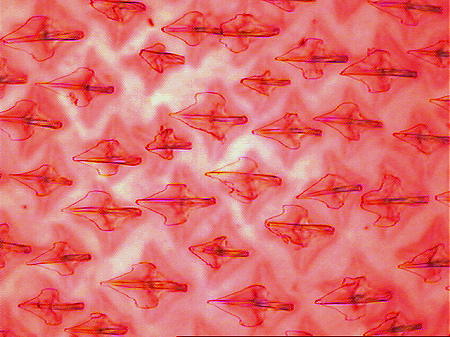
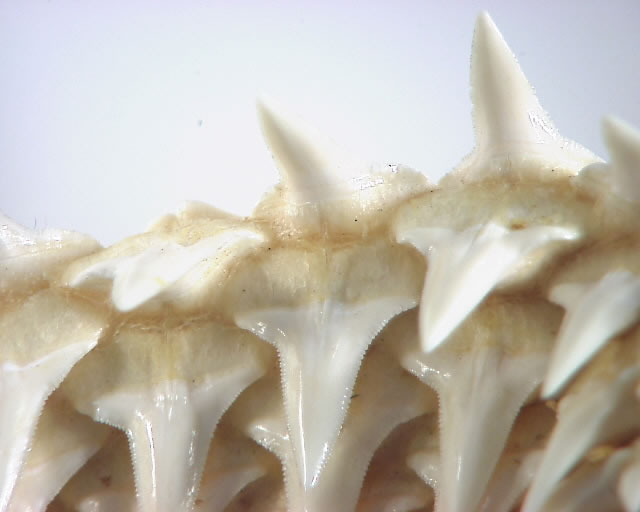
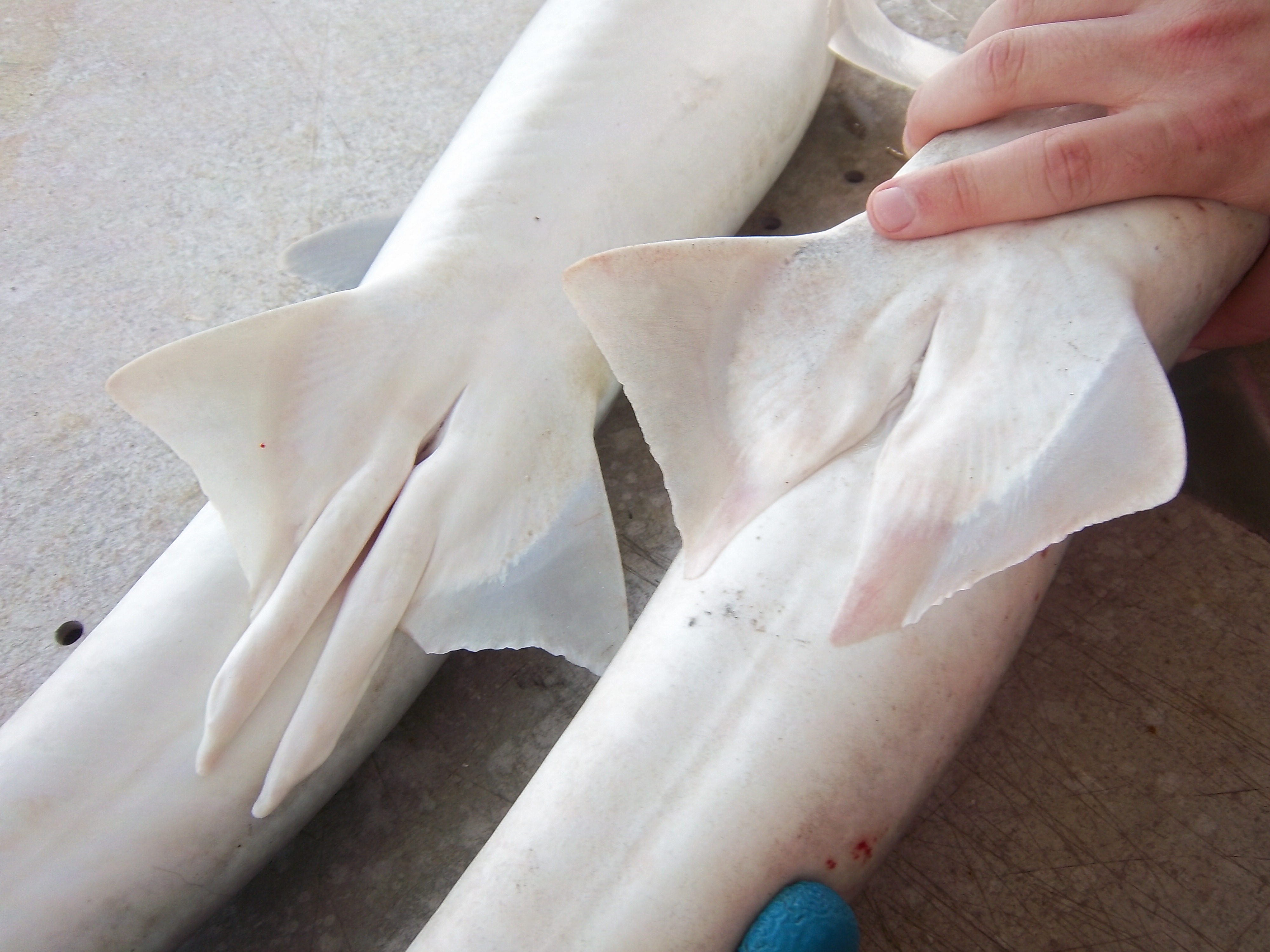
Chondrichthyes
That ominous music is playing again...DUH duh DUH duh DUH duh...heralding the approach of Chondrichthyans, the sharks, rays, and chimaeras!
WHAT'S IN A NAME: Chondrichthyans comes from the Latin root "chondr-", meaning cartilage. Unlike our own well-organized, calcified skeletons, chondrichthyan "bones" are made of cartilage, with prismatic calcification occurring throughout life. This condition is thought to be secondarily derived (the ancestors had calcified skeletons, but eventually lost them). This has implications for the shark and ray fossil record, as cartilage does not fossilize like bone does. This is why their evolutionary history is mainly based on fossilized teeth. Shark cartilage is thought by many to be a cure for joint diseases and disorders, but studies have proven to be quite inconclusive.
TEETH EVERYWHERE: Chondrichthyans are the first members of the group GNATHOSTOMES, meaning "jawed mouth." They have true jaws, as opposed to hagfish and lampreys. In these jaws are found rows and rows of teeth. Chondrichthyans are polyphyodonts, which means that they have continuous rows of teeth. When one tooth falls out, another one moves up to take its place. These teeth are true teeth, made of dentine (as opposed to the keratin teeth of lampreys). There are teeth elsewhere...ON THE SKIN. Chondrichthyans have placoid scales, otherwise known as dermal denticles, which develop in a similar fashion to the teeth in their mouths. It is unknown which came first, the "skin teeth" or the "mouth teeth."
SHARKTERCOURSE: Chondrichthyans, unlike many other marine animals, engage in INTERNAL fertilization. The male has a pair of copulatory organs, known as claspers, which he inserts into the cloaca of the female. It is interesting to note that the claspers of the male calcify as the animal reaches maturity.
AMPULLAE OF LORENZINI: These ampullae are gel-filled capsules found in the facial region of chondrichthyans. These sensory organs are used for electroreception. This is used for hunting prey, because they allow the fish to sense the electrical impulses produced by the prey to zero in and attack. This sense can even be used to find prey that isn't visible, as rays often hunt for shellfish buried in the sand.
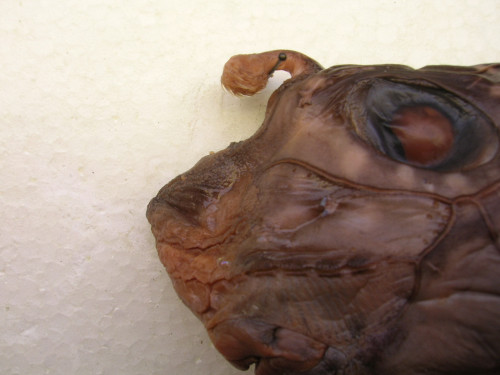
Holocephali: Chimaeras
This group contains one order (Chimaeriformes) and three families.
CHIMAERACTERISTICS: Chimaeras, in some aspects, are morphologically (physically) more similar to bony fish than they are to sharks and rays. Chimaeras have an opercular covering, so that their gill slits are not observable from the outside. Instead of replacable teeth, they have tooth plates which constantly grow. They cannot hyperextend their jaw due to fusion of the palatoquadrate (upper jaw) to the rest of the skull, referenced by the name "Holocephali" (whole head). Some species have a poisonous spine on their dorsal fin. Chimaeras also lack the placoid scales that are a characteristic of chondrichthyans, although some species have large scales on their cephalic clasper. This is a modified structure on the forehead of the male, which he uses to grasp the female during intercourse.
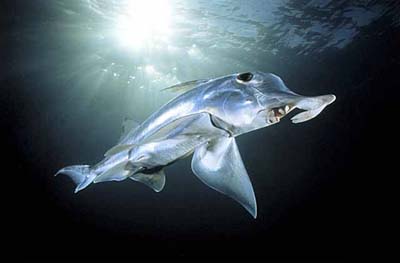
Callorhinchidae: Plownose Chimaeras
There is one genus (Callorhinchus), with three living species. They get their name from their distinctive snout, which is "elongate and flexible" according to Nelson. They most likely search for food through olfaction and electroreception, because they do not have good vision.
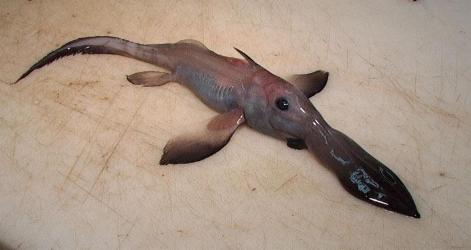
Rhinochimaeridae: Longnose Chimaeras
There are three genera in this family. This group is also distinguished by its snout, which is elongates in a paddle or conical shape. They also use their snout for feeding. The specimen to the right is known as a Pacific Spookfish.
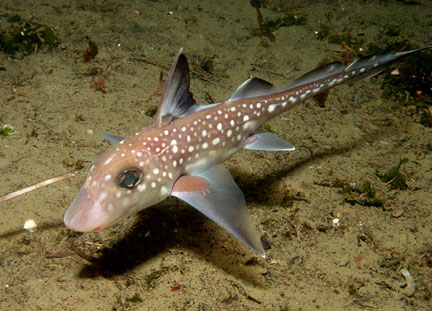
Chimaeridae: Chimaeras
This family has two genera. Unlike the other chimaera families, this group has a short, rounded snout. These are the chimaeras that have the cephalic clasper for mating. They are often called ratfish because of their strange nostrils and teeth.
Elasmobranchii
Elasmobranchii contains the sharks (Selachii) and rays (Batoidea).
UNIQUE CHARACTERISTICS:The sharks and rays are different in that they have separate gill slits (between 5 and 7). Many species also have a respiratory opening near the eyes, called a spiracle. The upper jaw is not fused to the cranium, so they are able to hyperextend their jaws for bigger bites. The front of the skull is open (imagine not having any bone between the skin of your forehead and your brain...).
Selachii
Honestly, there isn't much that's too unique about sharks. It's more that rays have numerous derived features that differentiate them (see Batoids below). Sharks have lateral gill slits, and do not have their pectoral fins attached to their head.
Galeomorphi
Pretty much the only excitement is the presence of an anal fin. Click the link to take an in-depth look at Galeomorph sharks.
Squalomorphi
These all lack an anal fin...except for Hexanchiformes. Click the link to take an in-depth look at Squalomorph sharks.
Batoidea
Here's where things get interesting! Batoids have ventral (bottom) gill openings, dorsal (top) eyes, and the pectoral fins are fused to their head! They have an extremely derived and recognizable shape, mainly because there are not many other fish that are flattened.